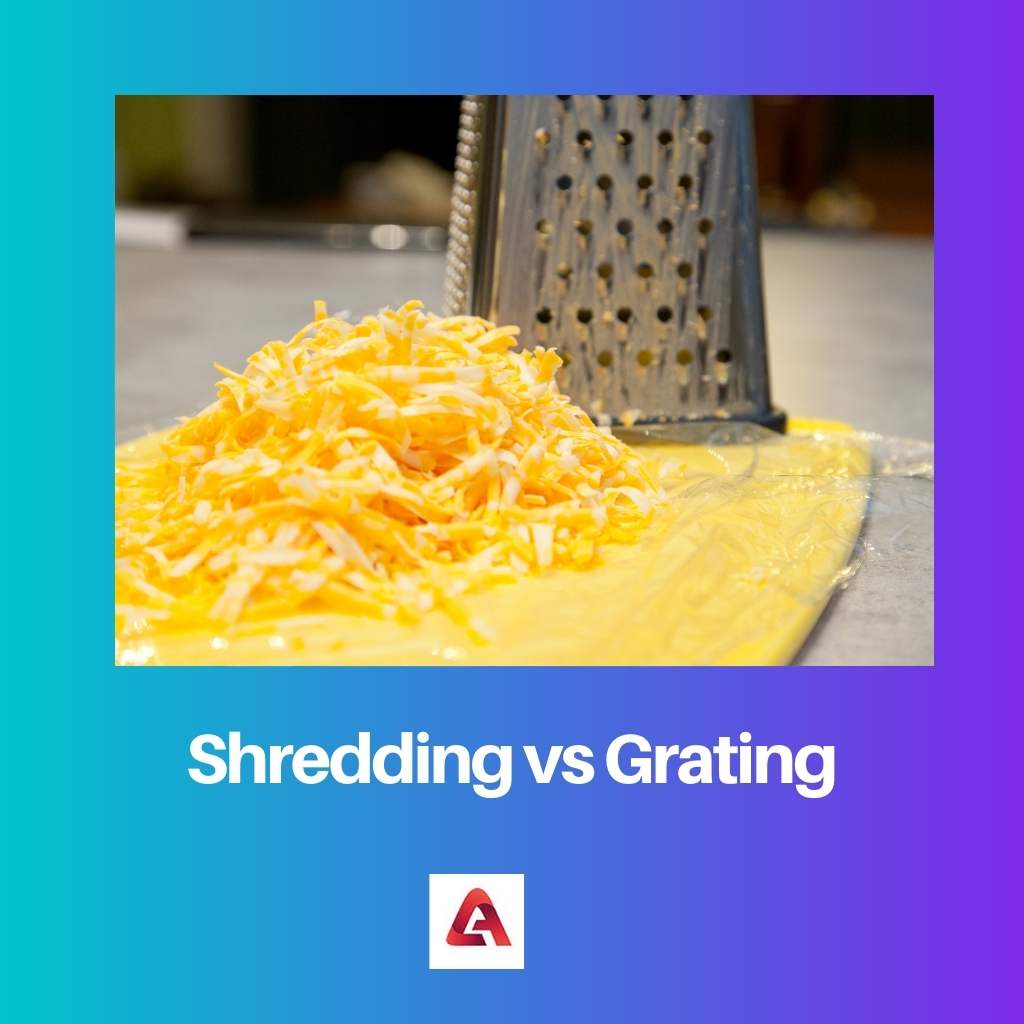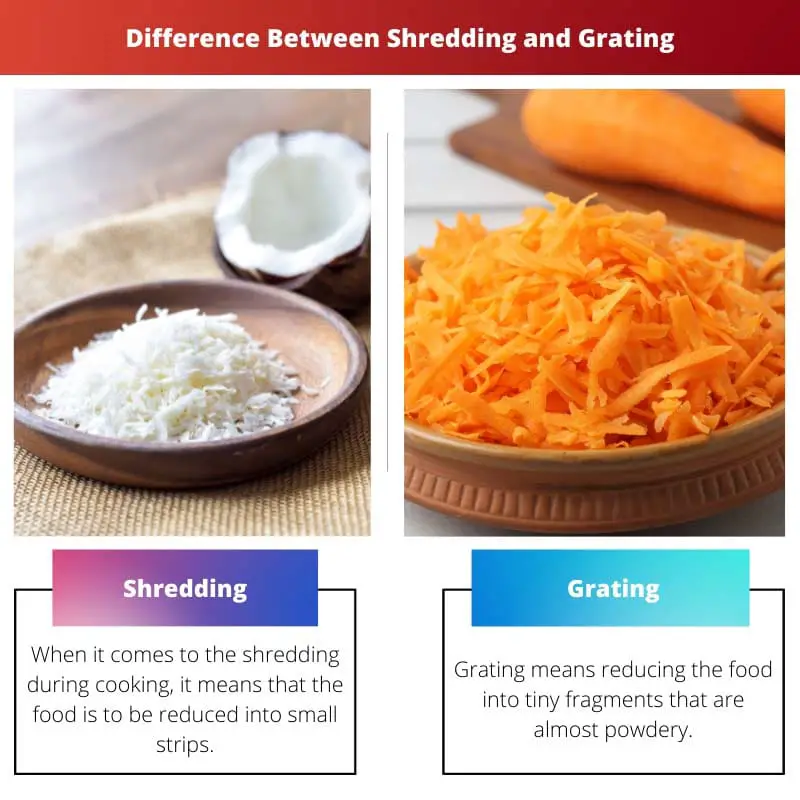Shredding involves cutting food into long, thin strips or strands using a shredder or sharp tool, resulting in larger pieces suitable for salads or garnishes. Grating, on the other hand, creates finer, uniform particles by rubbing food against a grater’s rough surface, ideal for incorporating ingredients evenly into recipes like cheese for melting or vegetables for baking.
Key Takeaways
- Shredding involves cutting food into thin, uniform strips, like cabbage or lettuce, for a salad.
- Grating involves rubbing food against a rough surface to produce small, coarse pieces, as with cheese or vegetables.
- Shredding is best for creating long, uniform pieces, while grating produces small, irregular pieces.
Shredding vs Grating
Shredding is a method of cutting food into thin, long pieces that can be used in various dishes, such as salads, sandwiches, tacos, and stir-fries. Grating is rubbing food against a rough surface to create small pieces. It can be used in various dishes, such as pasta, pizza, soups, and stews.

Shredding means cutting some into small strips called shreds. This process can be done using a hand grater or a box grater. The shredded food takes a longer time to cook.
Grating refers to the process in which the food is reduced to the tiniest pieces possible that may sometimes look like powder. The food can be grated using a grater with very small holes.
Comparison Table
| Feature | Shredding | Grating |
|---|---|---|
| Resulting Size | Thicker, longer strands | Finer, more textured particles |
| Tool Used | Shredder (box grater with large holes, food processor attachment) | Grater (box grater with small holes, microplane) |
| Application | Cheese (cheddar, mozzarella), vegetables (carrots, potatoes for hash browns), meat (chicken for stir-fries) | Cheese (hard cheeses like parmesan, for garnish), citrus zest (for flavor), spices (like nutmeg), vegetables (for salads or garnishes) |
| Texture in Dish | Noticeable pieces that add body and texture | Blends in more seamlessly, adds concentrated flavor |
| Melting | Melts slower due to larger surface area | Melts faster due to smaller surface area |
| Convenience | Faster, especially with large quantities | Slower, requires more effort |
What is Shredded?
Shredding is a culinary technique that involves cutting food items into thin strips or pieces, using specialized equipment such as a shredder or a sharp knife. This process is commonly employed for a variety of ingredients, including vegetables, fruits, meats, and cheeses, to achieve specific textures and enhance the presentation and flavor of dishes.
Method of Shredding
- Manual Shredding: For smaller quantities or when specialized equipment is not available, manual shredding with a knife or a vegetable peeler is common. This method requires precision and patience to achieve uniformly thin strips or pieces.
- Mechanical Shredding: Electric or manual shredding machines, equipped with sharp blades or rotating discs, are used to expedite the shredding process, especially in commercial kitchens or for large-scale food preparation. These machines offer consistency and efficiency in shredding various ingredients.
Applications of Shredding
- Salads and Garnishes: Shredded vegetables, such as carrots, cabbage, or lettuce, add texture and visual appeal to salads and coleslaws. They can also serve as vibrant garnishes for a variety of dishes.
- Toppings and Fillings: Shredded meats, such as chicken or pork, are commonly used as toppings for tacos, sandwiches, and pizzas, providing a convenient way to incorporate protein into meals. Additionally, shredded cheeses enhance the flavor and texture of dishes like nachos, quesadillas, and baked pasta.
- Baking and Cooking: Shredded ingredients, such as potatoes for hash browns or zucchini for fritters, are frequently used in baking and cooking to impart moisture and flavor while promoting even cooking and distribution of ingredients.
Considerations for Shredding
- Texture and Consistency: The size and texture of the shredded pieces can significantly impact the final dish. Fine shredding may be preferable for melting cheeses or incorporating into batters, while larger shreds may provide a more substantial bite in salads or fillings.
- Equipment and Safety: Choosing the appropriate shredding equipment and practicing proper safety measures, such as using protective gloves and securing the food item, are essential to prevent accidents and ensure efficient shredding.
- Ingredient Selection: Selecting fresh, high-quality ingredients and considering their natural flavors and textures can enhance the overall outcome of shredded dishes, resulting in a more satisfying culinary experience.

What is Grated?
Grating is a culinary technique used to break down solid food items into smaller, uniform pieces or particles by rubbing them against a grater’s rough surface. This method is employed to create fine textures and facilitate the incorporation of ingredients into various dishes, enhancing flavor, and improving consistency.
Process of Grating
- Box Grater: This traditional grater features multiple sides with various sizes of grating surfaces, including fine, medium, and coarse. It is suitable for grating a wide range of ingredients, such as cheeses, vegetables, and fruits, to achieve different textures.
- Microplane Grater: Also known as a rasp grater, this tool consists of a single, long, narrow grating surface with extremely fine blades. It is ideal for finely grating hard cheeses, citrus zest, spices, and nuts, producing delicate particles with intense flavors.
- Rotary Grater: This type of grater operates using a rotary mechanism, allowing for effortless grating of ingredients such as cheese or chocolate. It is particularly convenient for grating large quantities or when a finer texture is desired.
Applications of Grating
- Cooking and Baking: Grated ingredients, such as cheese, vegetables, or chocolate, are commonly used in cooking and baking to incorporate flavor and moisture into recipes. Grated cheese melts more evenly and quickly, while grated vegetables blend seamlessly into batters and fillings.
- Seasoning and Garnishing: Finely grated ingredients, such as citrus zest or spices, add brightness and complexity to dishes as seasoning or garnishes. They can be sprinkled over finished dishes or incorporated into sauces, dressings, and marinades for a burst of flavor.
- Texture Enhancement: Grated ingredients contribute to the overall texture of dishes, providing a smoother consistency in sauces, soups, and dips, or adding a crunchy topping to salads, casseroles, and gratins.
Considerations for Grating
- Quality of Ingredients: Selecting fresh, high-quality ingredients ensures superior flavor and texture in grated dishes. Hard cheeses, firm vegetables, and ripe fruits are particularly well-suited for grating.
- Grater Selection: Choosing the appropriate type of grater based on the desired texture and the specific ingredient being grated is essential for achieving consistent results. Experimenting with different graters allows for versatility in culinary applications.
- Technique and Safety: Practicing proper grating technique, such as holding the grater steady and using a controlled motion to avoid injury, is crucial for safety and efficiency. Additionally, cleaning the grater promptly after use prevents food residue from accumulating and ensures longevity.

Main Differences Between Shredded and Grated
- Texture:
- Shredding produces longer, thicker strands or pieces, offering a more pronounced texture suitable for salads, toppings, and fillings.
- Grating results in finer, uniform particles, ideal for incorporating ingredients evenly into recipes and creating smoother textures in dishes like sauces and soups.
- Equipment Used:
- Shredding requires a shredder or sharp knife to cut food into strips or pieces manually, or mechanical shredding machines for larger quantities.
- Grating involves rubbing food against a grater’s rough surface, utilizing tools such as box graters, microplane graters, or rotary graters to break down ingredients into smaller particles.
- Applications:
- Shredding is commonly used for ingredients like vegetables, meats, and cheeses in dishes such as salads, sandwiches, and casseroles.
- Grating is versatile, applied to a wide range of ingredients including cheese, vegetables, fruits, and spices, for seasoning, garnishing, baking, and cooking purposes.


The detailed comparison was great, the post goes to great lengths to show the differences and usages.
This article has a very educational element that can be useful for someone learning.
I agree, the content was well written and full of information.
The information was quite extensive and interesting.
I found the article thorough and comprehensive as well, well put together.
It’s a very informative post, it goes in great detail about both processes.
The explanation of ‘shredding’ and ‘grating’ was very informative and help in understanding the key differences between them.
The information regarding the food that can be shredded and grated was particularly insightful.
I agree, the post is comprehensive and gives a comprehensive idea about both processes.
The comparisons between shredding and grating are great, but it’s missing some pictures, it would make it easier to understand.
I agree, some visual aids like pictures or diagrams would make the point more clear.
I see what you’re saying. It would be nice to see some examples.
The article has made the information clear about what each process consists of, it’s a great post for someone who is just starting to cook.
I think the process of cutting strips has been put into simpler terms for a beginner, which is helpful.
The comparisons laid out are very detailed, it makes us realize that these two processes are not only different but also have different applications.
Right, I found the information about the food to be shredded very enlightening, I never thought coconut could be shredded.
I think that the post did really well explaining the differences and the times for each process, very instructive.
The post goes really in-depth about the concept of shredding and grating, it’s very informative and at the same time, it’s clear and not dull.
I’m impressed by the depth of knowledge the article provided, it’s very thorough and touched all aspects.
The post was indeed comprehensive and instructive.
The content managed to give a clear image of both the processes.
The pairings of different aspects of each process are great and the level of detail is just right. Good balance between details and overview.
The post highlights every aspect of shredding and grating, which was quite impressive.
The content was detailed and comprehensive, with great facts and comparisons.
The facts are well presented and laid out clearly, it’s informative without being too technical.
I found this article to be quite informative and detailed, it’s an excellent guide for beginners to understand the differences.